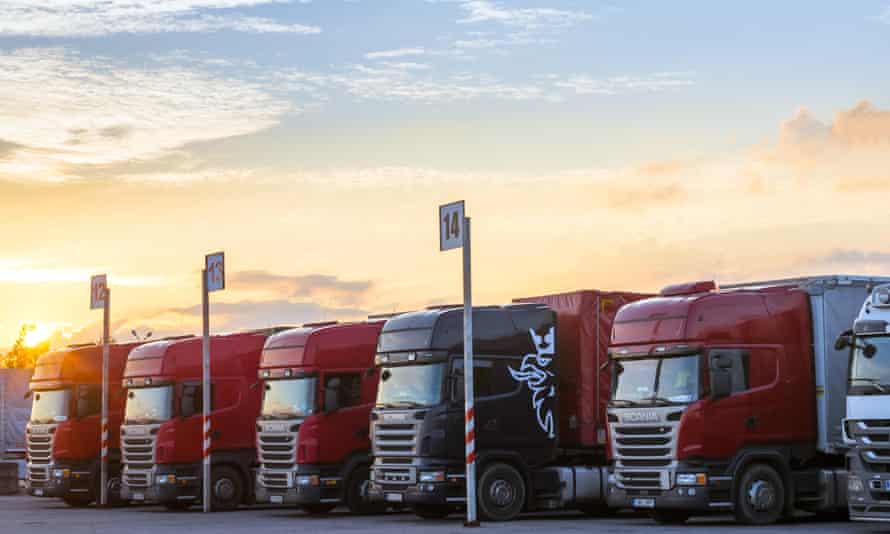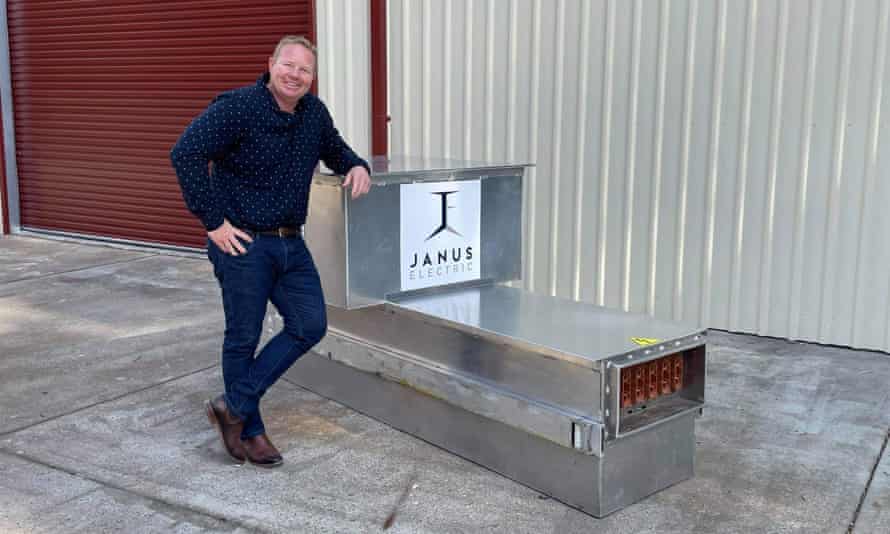Batteries can be swapped in three minutes, removing the need for trucks to plug in and charge.

Charge-and-change stations for heavy vehicles using the Janus Electric battery will be placed to coincide with mandatory driver fatigue breaks along the Pacific Highway.
Last modified on Thu 29 Apr 2021 03.32 AEST
An Australian company is planning to trial electric trucks with swappable batteries allowing almost non-stop travel for heavy vehicles between Sydney and Brisbane.
Developed by Janus Electric, the batteries can be swapped in three minutes, removing the need for trucks to plug in and charge for up to 12 hours.
The batteries will reportedly average between 400-600km a charge, with drivers only needing to stop at placed charge-and-change stations along the initial Brisbane-Sydney trial route.
The stations will be located strategically, to coincide with mandatory driver fatigue breaks, including at Hemmant in Brisbane, Taree and Coffs Harbour on the Pacific Highway, and Prestons in Sydney.
Lex Forsyth, Janus Electric’s general manager, explained that the process wasn’t as complicated as it sounded.
“What we’ve been able to do is create a standard battery form factor that can fit in 90% of trucks. You can liken the model to a swap-and-go gas bottle. You don’t care what gas bottle you get, as long as you get your 9kg of gas. That’s how we’ve designed the system.”
“It’s remarkably simple, but it’s about being able to bring all the best technology in the one place.”
Forsyth said Janus Electric had worked on developing a quick and simple process for the swapping of batteries.
“The truck drives into a change and charge station, there’s batteries already on the rack, where they’re sitting charged or being charged, and our software system is behind that, ensuring there are always batteries there to exchange.”
Forsyth says each conversion would cost approximately $85,000 a vehicle, but fleet operators would receive their old diesel engine in return, which he said could fetch up to $15-25,000 on the used market.
He thought users could break even after just a year, when factoring in savings on maintenance and the sale of the engine.
Typically, conversions take around a week, and will be carried out on trucks that are already due for an engine rebuild, which often comes around every five years.
“It’s usually the diesel engine that’s worn out, not the rest of the truck,” he said, “so, instead of spending money on the rebuild, they can convert their trucks.”
Forsyth thinks the switch to interchangeable batteries could have a monumental impact on the industry, starting with alleviating the dependence on oil prices.
“We can actually start giving the industry a fixed energy cost. There’s no exposure to the oil market. Most businesses have a fuel surcharge they pass on to customers, but we can fix our cost in for fleet operators.”
He also said maintenance costs, one of the largest expenses for fleet operators, would also be reduced by the introduction of exchangeable batteries.
“Typically a prime mover will cost you between 7.5-8 cents/km, an older one you’re looking in excess of 14 cents/km in maintenance. But we’d bring it down to 3 cents/km.”
Forsyth stressed how much the change would also benefit drivers, with the engines running much quieter than traditional diesel engines.

‘It’s just a quieter, more efficient truck to drive’: Lex Forsyth from Janus Electric with his swappable battery designed for heavy vehicles.
“It’s just a quieter, more efficient truck to drive.”
He said he was confident the industry would take up the batteries, saying many were now thinking about their carbon footprint.
“Customers are definitely now looking at their carbon footprint, and looking how they can become better corporate citizens.”
“The economic numbers make so much sense for a fleet operator to make the change, because our balance of change is the oil prices, and we believe with the push for net zero carbo targets, that we’ll see significant uptake.”
Australian Trucking Association (ATA) Transport and Infrastructure adviser Sam Marks said the innovative approach to trucking was welcomed, but needed to be paired with additional work from the government.
“The ATA welcomes Australian innovation to advance zero and low emission road transport, such as through the ongoing development of exchangeable batteries.
“The application of this technology will depend on the proposed trials, the commercial needs of individual trucking businesses and vehicle manufacturer requirements.”
In a statement, the ATA said they believed that access to new truck models, moves to mass production and more cost-competitive models will be imperative to the transition to zero and low emission technologies
“This transition needs to include the electric and hydrogen trucks that manufacturers are making available overseas. Governments need to address vehicle design rules, the availability of recharging and refuelling infrastructure, and the need for a temporary purchase incentive to accelerate the introduction of zero and low emission heavy vehicles into the Australian market.”
Behyad Jafari, chair of the Electric Vehicle Council, said the trial of the trucks was a reflection of the trucking industry’s desire to find solutions to its carbon footprint.
“Certainly in the trucking industry, I see a lot of enthusiasm by logistics operators and their customers, to decarbonise, recognising they do have a role to play in addressing our decarbonisation efforts, and also recognising the benefit of new technologies.”
“This is pretty typical of Australian ingenuity in this global transition to electrification, and we see Aussie companies leading the way in innovation and coming up with solutions.”
Jafari warned there would be some barriers and obstacles to overcome before the technology is more widely adopted, but that he was hopeful of the results.
“We are seeing more entrants in the trucking industry developing and producing more electric trucks, but like with anything else, when new technologies are introduced, there’s a bit of learning involved.”
“Those big barriers include what the technology is actually capable of, in addition to the more cultural barriers, that time that needs to be spent by companies to explore and understand the benefits of moving to electric trucks.”
One particular challenge that Jafari focused on was the cost, saying it was imperative that the long-term reduction in running costs balance out any upfront expenses.
“You’ll usually end up with higher up-front costs and lower operating costs, which means in the long term, it’ll be cheaper to run an electric heavy transport network.”
“If their competitors overseas are able to move to electric vehicles and significantly lower their operating costs, and they aren’t able to do so here, that would be a burden on them.”
“And of course when you do that, you’re reducing emissions from a very large source of emissions.”
Forsyth said the next step was to continue testing the vehicles, and that he hoped to have five vehicles in the pilot program by November.
Janus Electric will be taking orders for conversions after the Brisbane Truck Show, where they hope to exhibit the technology.
Within five years, they hope to have more than 1,000 trucks in their system.
No comments:
Post a Comment